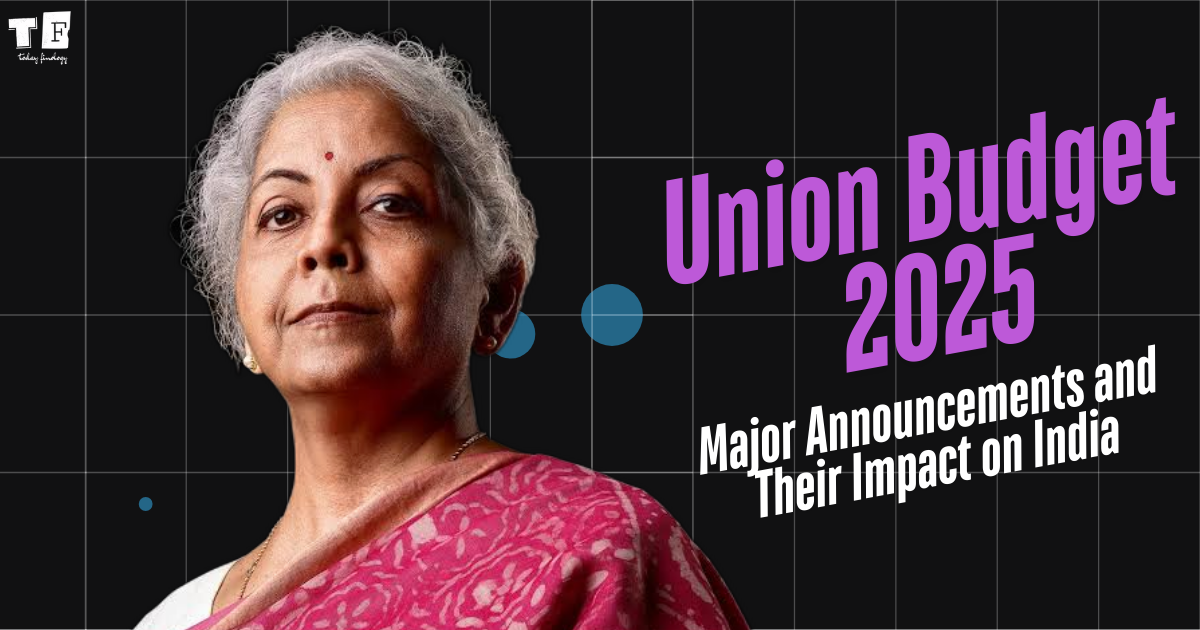Union Budget 2025: Major Announcements and Their Impact on India
The Union Budget 2025-26, presented by Finance Minister Nirmala Sitharaman, introduces significant reforms for tax relief, infrastructure development, and economic growth. The budget focuses on strengthening the middle class, modernizing Indian Railways, simplifying taxation, and making essential goods more affordable.
Let’s break down the key highlights and their impact on ordinary people and businesses.
1. Major Tax Relief: No Tax on Income Up to ₹12 Lakh
One of the most discussed aspects of this year’s budget is the tax exemption for individuals earning up to ₹12 lakh annually. While this does not mean complete tax exemption, the government’s rebates ensure zero tax liability for most salaried individuals in this income bracket.
Understanding the Tax Slabs:
- ₹4-8 lakh: Taxed at 5% (₹20,000)
- ₹8-12 lakh: Taxed at 10% (₹40,000)
- Government rebates bring the final Tax payable to zero
This move is expected to increase disposable income, encourage spending, and boost economic activity.
However, individuals earning through capital gains, stock investments, or lottery winnings will still need to pay taxes, as unique income sources do not fall under the rebate policy.
2. Indian Railways: Expansion and Modernization
The government has allocated ₹2.52 lakh crore to the Indian Railways, one of the highest ever. Major projects include:
- 200 new Vande Bharat trains to improve high-speed rail connectivity.
- 100 Amrit Bharat trains for long-distance travel.
- 1,000 new railway flyovers for better road connectivity.
- 17,500 new train coaches to enhance passenger experience.
This significant investment aims to reduce travel time, increase efficiency, and modernize railway infrastructure, making travel safer and more comfortable for millions of passengers.
3. Relief for Middle-Class: Affordable Electronics and Medicines
The budget focuses on reducing import duties on essential items, making various goods more affordable:
- Custom duty on electronic goods like mobile phones and EV batteries has been reduced, making them cheaper.
- 36 life-saving medicines are now duty-free, reducing healthcare costs.
This step will benefit consumers and encourage domestic manufacturing, making India a competitive market in electronics and healthcare.
4. TDS and TCS Reforms: Easier Tax Compliance
The budget introduces key changes in Tax Deducted at Source (TDS) and Tax Collected at Source (TCS):
- TDS limit on rental income increased from ₹2.4 lakh to ₹6 lakh, benefiting landlords.
- TCS on education loans up to ₹10 lakh removed, making education loans more affordable.
- TCS payment delays are no longer a criminal offense, reducing legal stress for businesses.
These reforms simplify taxation and improve financial flexibility for individuals and businesses.
5. Standard Deduction Remains Unchanged
Despite expectations, the standard deduction for salaried employees remains at ₹50,000. Experts believe this decision is part of the government’s focus on overall tax relief through slab adjustments rather than increasing deductions.
While some taxpayers were hoping for a higher deduction, the overall impact of zero Tax up to ₹12 lakh still provides significant relief.
6. Business Leaders’ Reactions: More Purchasing Power for the Middle Class
Shark Tank India investor and businessman Anupam Mittal called this budget historic for the middle class. He compared it to economic policies in China and the USA, saying:
“A strong economy is built on a wealthy middle class, not an overtaxed one.”
This statement reflects the government’s approach to reducing the tax burden to increase consumer spending and economic growth.
7. Capital Gains and Special Income Tax Rules
While salaried individuals earning up to ₹12 lakh get tax relief, the rule does not apply to capital gains and exceptional incomes, such as:
- Profits from stock market investments
- Earnings from property sales
- Lottery winnings and gambling income
These income sources are taxed separately at higher rates, ensuring high-income earners still contribute their fair share to the economy.
8. Understanding the Difference Between TDS and TCS
Many often confuse TDS (Tax Deducted at Source) with TCS (Tax Collected at Source). The budget clarifies their difference:
- TDS: Deducted before salary, rent, or commission is paid.
- TCS: Collected at the time of sale for certain products like metals, automobiles, and minerals.
This explanation helps taxpayers understand their financial obligations better.
9. Why ₹12 Lakh Income Is Not Fully Tax-Free
A common misconception is that earning ₹12 lakh means paying zero Tax. However, the reality is:
- Income between ₹4-8 lakh is taxed at 5%.
- Income between ₹8-12 lakh is taxed at 10%.
- Government rebates cancel out the tax amount, making final tax liability zero.
Thus, it is not tax-free but tax-exempt due to rebates. This is an essential distinction for taxpayers to understand.
10. Old vs. New Tax Regime: Key Benefits
While the new tax regime offers benefits like zero Tax on ₹12 lakh, some people may still prefer the old regime due to:
- Home loan interest deduction (₹2 lakh)
- Tax-saving investments under Section 80C (₹1.5 lakh)
- Health insurance premium benefits
Those with high deductions may still benefit from the old system, while others might find the new regime more suitable.
Conclusion: A Budget Focused on Growth and Middle-Class Benefits
The Union Budget 2025-26 is designed to empower the middle class, modernize infrastructure, and simplify tax policies. Key takeaways include:
✅ Zero Tax up to ₹12 lakh, increasing disposable income
✅ Major railway expansion, improving connectivity
✅ Cheaper electronic goods and medicines, reducing daily expenses
✅ Simplified TDS/TCS rules, making financial management easier
With these measures, the government aims to boost economic growth while ensuring financial relief for citizens.















Post Comment